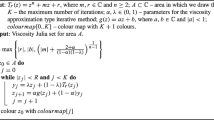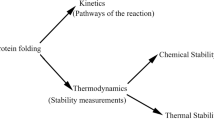Abstract
We discuss the fractal nature of protein folds and some mathematical apparatus to describe them. In particular, the scaling symmetry of such selfsimilar objects is described using semigroup theory. As is also shown, purely mathematical considerations may open the way toward a possible rational design of a wide class of synthetic folds of diverse chemical nature (for potential nanotechnological applications). In this regard, a special role is given to the Walsh functions and associated with them molecular constructions called Walsh copolymers.
Similar content being viewed by others
References
G. de Gennes, Scaling Concepts in Polymer Physics (Cornell University, Ithaca, 1979)
D.A. Klein, W.A. Seitz, J.E. Kilpatrick, Branched polymer models. J. Appl. Phys. 53(10), 6599–6603 (1982)
D.J. Klein, W.A. Seitz, Self-similar self-avoiding structures: models for polymers. PNAS 80(10), 3125–3128 (1983)
D.J. Klein, W.A. Seitz, Graphs, polymer models, excluded volume, and chemical reality, in Topology and Graph Theory in Chemistry, ed. by R.B. King (Elsevier, Amsterdam, 1983), pp. 430–445
L. Bytautas, D.J. Klein, M. Randić, T. Pisanski, Foldedness in linear polymers: a difference between graphical and Euclidean distances. DIMACS Ser. Discrete Math. Theor. Comput. Sci. 51, 39–61 (2000)
Y. Almirantis, A. Provata, An evolutionary model for the origin of non-random long-range order and fractality in the genome. BioEssays 23, 647–656 (2001)
N.N. Oiwa, J.A. Glazier, The fractal structure of the mitochondrial genomes. Phys. A 311, 221–230 (2002)
M.A. Moret, J.G. Miranda, E. Noqueira Jr, M.C. Santana, G.F. Zebende, Self-similarity and protein chains. Phys. Rev. E Stat. Nonlinear Soft Matter Phys. 71(1 Pt 1), 012901 (2005)
C. Cattani, Fractals and hidden symmetries in DNA. Math. Probl. Eng. 2010, Article ID 507056, 1–31
N. Todoroff, J. Kunze, H. Schreuder, K.-H. Baringhaus, G. Schneider, Fractal dimensions of macromolecular structures. Mol. Inf. 33, 588–596 (2014)
R. Hancock, Structures and functions in the crowded nucleus: new biophysical insights. Front. Phys. 2(53), 1–7 (2014). doi:10.3389/fphy.2014.00053
R.P. Bywater, Protein folding: a problem with multiple solutions. J. Biomol. Struct. Dyn. 31(4), 351–362 (2013)
A. Ben-Naim, Levinthal’s question revisited, and answered. J. Biomol. Struct. Dyn. 31(4), 113–124 (2013)
I.N. Berezovsky, V.M. Kirzhner, A.Z. Kirzhner, V.R. Rosenfeld, E.N. Trifonov, Closed loops: persistence of the protein chain returns. Protein Eng. 15(12), 955–957 (2002)
I.N. Berezovsky, A.Z. Kirzhner, V.R. Rosenfeld, E.N. Trifonov, Protein sequences yield a proteomic code. J. Biomol. Struct. Dynam. 21(3), 317–326 (2003)
N. Papandreou, I.N. Berezovsky, A. Lopes, E. Eliopoulos, J. Chomilier, Universal positions in globular proteins. From observation to simulation. Eur. J. Biochem. 271, 4762–4768 (2004)
V.R. Rosenfeld, Using semigroups in modeling of genomic sequences. MATCH Commun. Math. Comput. Chem. 56(2), 281–290 (2006)
A.H. Clifford, G.B. Preston, The Algebraic Theory of Semigroups, 2nd edn. (American Mathematical Society, Providence, 1967)
P.M. Higgins, Techniques of Semigroup Theory (Oxford University Press, Oxford, 1992)
L.N. Shevrin, Semigroups, in General Algebra, vol. 2, ed. by L.A. Skornyakov (Nauka, Moscow, 1991), pp. 11–191. (in Russian)
G. Lallement, Semigroups and Combinatorial Applications (Wiley, New York, 1979)
T.S. Blyth, M.H. Almeida, Regular semigroups with skew pairs of idempotents. Semigroup Forum 65, 264–274 (2002)
V.R. Rosenfeld, Emulating the function of introns in pre-mRNA. MATCH Commun. Math. Comput. Chem. 57(1), 135–142 (2007)
V.R. Rosenfeld, D.J. Klein, Implications of sense/antisense nucleic-acid codons on amino-acid counts. Stud. Univ. Babes-Bolyai Chem. 55(4), 167–176 (2010)
V.R. Rosenfeld, Color symmetry, semigroups, fractals. Croat. Chem. Acta 86(4), 555–559 (2013)
V.R. Rosenfeld, D.J. Klein, Cyclic nucleotide sequences codonically invariant under frame shifting. Stud. Univ. Babes-Bolyai Chem. 55(4), 177–182 (2010)
V.R. Rosenfeld, Studying the polypeptide sequence (\(\alpha \)-code) of Escherichia coli. J. Theor. Chem. (2013). Article ID 961378
B.B. Mandelbrot, The Fractal Geometry of Nature (W. H. Freeman and Co., New York, 1982)
M.F. Barnsley, H. Rising, Fractals Everywhere (Academic Press Professional, Boston, 1993)
J.-F. Gouyet, Physics and Fractal Structures (foreword by B. Mandelbrot), Masson (Springer, New York, 1996)
K. Falconer, Techniques in Fractal Geometry (Wiley, New York, 1997)
V.R. Rosenfeld, Equivalent genomic (proteomic) sequences and semigroups. J. Math. Chem. 53(6), 1488–1494 (2015)
V.R. Rosenfeld, Selfcomplementary, selfreverse cyclic nucleotide sequences codonically invariant under frame shifting. J. Math. Chem. 51(10), 2644–2653 (2013)
N.C. Seeman, H. Wang, X. Yang, F. Liu, C. Mao, W. Sun, L. Wenzler, Z. Shen, R. Sha, H. Yan, M.H. Wong, P. Sa-Ardyen, B. Liu, H. Qiu, X. Li, J. Qi, S.M. Du, Y. Zhang, J.E. Mueller, T.-J. Fu, Y. Wang, J. Chen, New motifs in DNA nanotechnology. Nanotechnology 9, 257–273 (1998)
N.C. Seeman, At the crossroads of chemistry, biology, and materials: structural DNA nanotechnology. Chem. Biol. 10, 1151–1159 (2003)
S.M. Douglas, H. Dietz, T. Liedl, B. Högberg, F. Graf, W.M. Shih, Self-assembly of DNA into nanoscale three-dimensional shapes. Nature 459, 414–418 (2009)
H. Dietz, S.M. Douglas, W.M. Shih, Folding DNA into twisted and curved nanoscale shapes. Science 325, 725–730 (2009)
Y. Ke, S.M. Douglas, M. Liu, J. Sharma, A. Cheng, A. Leung, Y. Liu, W.M. Shih, H. Yan, Multilayer DNA origami packed on a square lattice. J. Am. Chem. Soc. 131, 15903–15908 (2009)
H. Gradišar, R. Jerala, Self-assembled bionanostructures: proteins following the lead of DNA nanostructures. J. Nanobiotechnol. 12(4), 1–9 (2014)
L. Jaeger, E. Westhof, N.B. Leontis, TectoRNA: modular assembly units for the construction of RNA nano-objects. Nucleic Acids Res. 29(2), 455–463 (2001)
K.A. Afonin, M. Kireeva, W.W. Grabow, M. Kashlev, L. Jaeger, B.A. Shapiro, Co-transcriptional assembly of chemically modified RNA nanoparticles functionalized with siRNAs. Nano Lett. 12(10), 5192–5195 (2012)
Y. Shu, F. Haque, D. Shu, W. Li, Z. Zhu, M. Kotb, Y. Lyubchenko, P. Guo, Fabrication of 14 different RNA nanoparticles for specific tumor targeting without accumulation in normal organs. RNA 19, 767–777 (2013)
J.G. Heddle, Protein cages, rings and tubes: useful components of future nanodevices? Nanotechnol. Sci. Appl. 1, 67–78 (2008)
J.L. Walsh, A closed set of normal orthogonal functions. Am. J. Math. 45, 5–24 (1923)
N.J. Fine, On the Walsh functions. Trans. Am. Math. Soc. 65, 372–414 (1949)
K.G. Beauchamp, Walsh Functions and Their Applications (Academic Press, London, 1975)
S.G. Tzafestas, Walsh Functions in Signal and Systems Analysis and Design (Van Nostrand Reinhold, New York, 1985)
J. Hadamard, Résolution d’une question relative aux déterminants. Bull. Sci. Math. 17, 240–246 (1893)
A. Hedayat, W.D. Wallis, Hadamard matrices and their applications. Ann. Stat. 6(6), 1184–1238 (1978)
A.P. Bisson, F.J. Carver, D.S. Eggleston, R.C. Haltiwanger, C.A. Hunter, D.L. Livingstone, J.F. McCabe, C. Rotger, A.E. Rowan, Synthesis and recognition properties of aromatic amide oligomers: molecular zippers. J. Am. Chem. Soc. 122, 8856–8868 (2000)
D.G. Allis, J.T. Spencer, Nanostructural architectures from molecular building blocks, in Handbook of Nanoscience, Engineering, and Technology, Ch. 18, 2nd edn., ed. by W.A. Goddard Iii, D.W. Brenner, S.E. Lyshevski, G.J. Iafrate (CRC Press LLC, Boca Raton, 2007)
A. Banerji, Studying protein interior with fractal dimension, in Fractal Symmetry of Protein Interior, Ch. 2, (SpringerBriefs in Biochemistry and Molecular Biology, Springer, Basel, 2013) pp. 84. doi: 10.1007/978-3-0348-0651-0_2
Acknowledgments
The author is grateful to Prof. Douglas J. Klein (Galveston) and anonymous Referees for their helpful comments. This work was supported by the Welch Foundation of Houston, Texas (through Grant BD-0894) and the Ministry of Absorption of the State Israel (via fellowship “Shapiro”).
Author information
Authors and Affiliations
Corresponding author
Rights and permissions
About this article
Cite this article
Rosenfeld, V.R. The fractal nature of folds and the Walsh copolymers. J Math Chem 54, 559–571 (2016). https://doi.org/10.1007/s10910-015-0574-7
Received:
Accepted:
Published:
Issue Date:
DOI: https://doi.org/10.1007/s10910-015-0574-7




